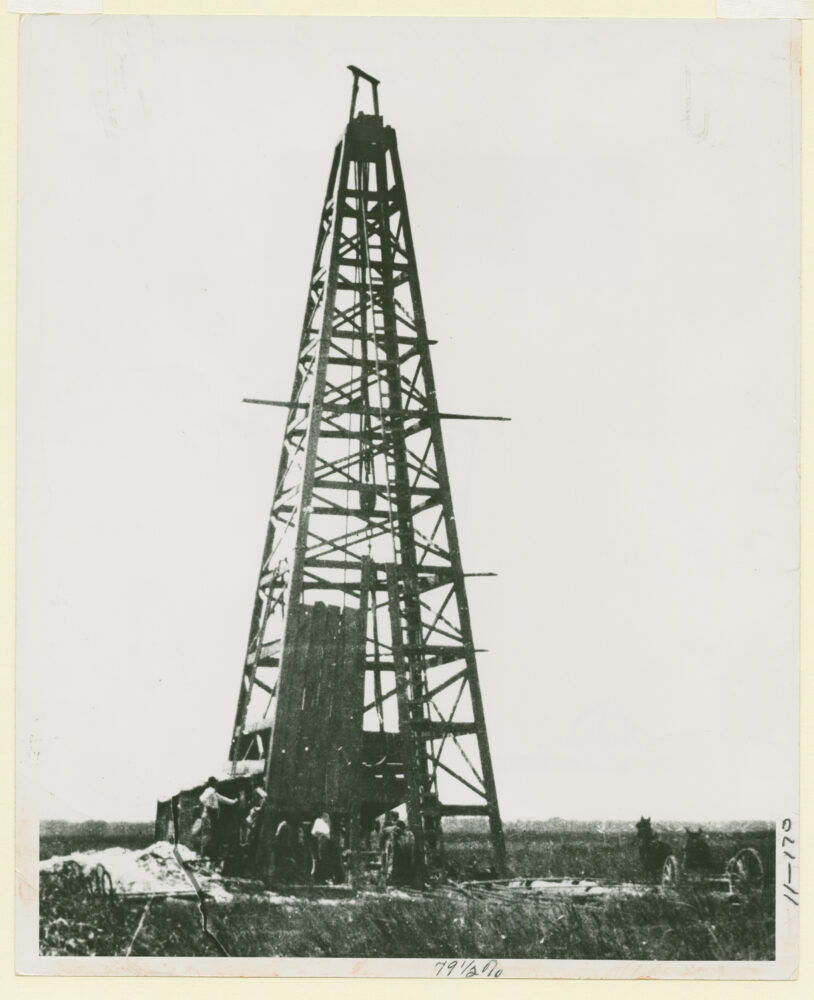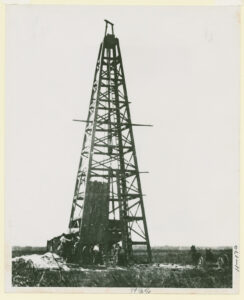First Louisiana Oil Well
Exploitable petroleum deposits were found in Louisiana in 1901, changing the state's economy and landscape forever.

The Historic New Orleans Collection
Louisiana's first oil well, near Jennings, ca. 1901.
Louisiana’s oil and gas industry began in 1901 with the first commercial oil discovery in the Evangeline field just northeast of Jennings in Acadia Parish. Brothers W. Scott, Alba, O. W., Clint, and Dewey Heywood, founders of the Heywood Oil Company, are credited with bringing in the state’s first major oil well. Their discovery ignited a century of oil and gas development in the state and transformed Louisiana’s economy and way of life.
In 1901, the Heywood brothers, veterans of the Texas oil boom, traveled to the Jennings area to investigate gas seeps in a rice field owned by Jules Clement, a French-speaking farmer. Oil men had long recognized that gas seeps showed signs of oil fields below the surface. The Heywoods negotiated an oil lease with the farmer to drill on his land, with a contract to drill two wells at a thousand feet each. They set up the Jennings Oil Company and hired a driller from Spindletop, Texas. After coming up short with the first thousand feet of drill pipe, they made the risky decision to drill the second well beginning at the bottom of the first well. On September 21, 1901, the drillers hit an oil sand formation and created a “gusher” that blew out from the top of the drilling structure. A second successful well drilled adjacent to the first produced seven thousand barrels of oil a day, confirming the discovery of Louisiana’s first oil field.
For the next several years, the Evangeline field, known also as the Jennings field, underwent extensive development. Production rapidly increased to one hundred thousand barrels a day. The Heywoods established the Jennings-Heywood Syndicate to operate several leases in the field. They built pipelines, storage tanks, and loading racks near a railroad to move the oil to markets. They piped oil onto barges parked near the Mermentau River to be shipped to buyers along Louisiana’s waterways. The oil provided a cheap new fuel source for the region’s growing agriculture industry. Most of the Jennings oil was used as fuel for industries, such as rice and sugar cane, within a hundred miles of the field.
As with all pioneering ventures, these early oil men faced many challenges. They battled terrible fires and wasteful gushers. Word of the discovery caused a mad rush of drilling from many competitors that led to overproduction. The Heywoods responded by storing excess crude production in massive aboveground earthen tanks. These tanks or pits were later converted to store produced saltwater, a waste product of oil operations, which led to unintended environmental impacts over the years, such as soil contamination.
The oil discovery transformed Jennings into a boomtown and the first center for oil in the state. The influx of investors, workers, equipment dealers, and land speculators into the Jennings region brought a great deal of wealth and capital to this burgeoning rice farming town. By the time oil production from the historic field declined in 1907, it had produced fifty million barrels of oil. The black gold made the local landowners rich; Jules Clement became a millionaire by today’s standards.
The discovery and development of Louisiana’s first oil field represented the beginning of an energy transition for the nation and a new economic enterprise for Louisiana. Three decades after the historic discovery, the oil and gas business grew to become the state’s main industry, surpassing all other traditional economic activities combined.
